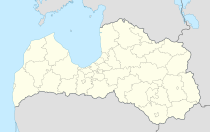Aizkraukle
| Aizkraukle | ||
|---|---|---|
 |
|
|
| Basic data | ||
| State : |
|
|
| Landscape: | Livonia ( Latvian : Vidzeme ) | |
| Administrative district : | Aizkraukles novads | |
| Coordinates : | 56 ° 39 ′ N , 25 ° 15 ′ E | |
| Residents : | 7,315 (Jun 3, 2015) | |
| Area : | 11.645 km² | |
| Population density : | 628 inhabitants per km² | |
| Height : | 46 m | |
| City law: | since 1967 | |
| Website: | www.aizkraukle.lv | |
| Post Code: | ||
| ISO code: | ||
Aizkraukle , in the years of the Soviet occupation of Latvia until 1991 Stučka (the German name Ascheraden is no longer used), is a Latvian city with about 7,300 inhabitants (as of 2015). It lies on the right high bank of the Daugava (Düna), opposite the Lauce tributary.
The city forms the eponymous center of its own administrative district and is located about 90 km southeast of Riga in the glacial valley of the Daugava.
geography
The city is in close proximity to the dam of the Plavinas hydroelectric power station on the Riga - Daugavpils railway line . The surrounding area is mainly covered by forest and lakes or rivers.
history
According to excavations, the area represents an old historical settlement of the Livs . The northern bank of the Daugava was Livonian territory, while the area to the left of the Daugava belonged to Zemgals . The Ascheraden Commandery and later the Ascheraden parish had their center here. The name “Ascheraden” (Low German: “Asscrade”), which sounds like “Ašķere” in Latvian, describes the left tributary of the Daugava, which flows here.
According to the Latvian legend of Lāčplēsis ("Bear Ripper"), the hero met the beautiful witch Spīdola, daughter of Aizkrauklis, the guardian of the rapids there, on his hike .
The current city of Aizkraukle, north of the Daugava, was founded in 1960 during the construction of the Plavinas hydropower plant under the name Stučka - after Lenin's first People's Commissar for Justice and temporary President of Latvia Pēteris Stučka - as a housing estate for construction workers and hydropower plants. Aizkraukle's architecture is therefore characteristic of the 1960s and 1970s. The settlement at the hydroelectric power station at that time received city rights in 1967. The city was renamed Aizkraukle in 1991 after a nearby village. In 2001 Aizkraukle was appointed the administrative center of the region of the same name.
Hydroelectric power plant
The Pļaviņas hydropower plant ( Pļaviņu hidroelektrostacija , mostly abbreviated: Pļaviņu HES) is the largest in Latvia. In 2015 it generated 1,022 GWh , which is 57% of the total energy supplied by the three Latvian hydropower plants on the Daugava. It is located 107 km from the confluence of the Daugava and the Riga Bay . The construction period was seven years: from 1961 to 1968. With a storage height of a maximum of 40 meters, the power plant has a capacity of 893,500 kW .
Town twinning
Aizkraukle has three twin cities:
- Eppstein (Germany), since 1998,
- Biržai (Lithuania), since 2004
- Kiskunhalas (Hungary), since 2005
See also
literature
- Johann Karl Bähr: The graves of the Livs . Rudolf Kuntze, Dresden 1850. With numerous illustrations, online
- Karl (also: Carl) von Löwis of Menar : Burgenlexikon für Alt-Livland . Riga, 1922
- Andrejs Pumpurs (1841–1902): Bearslayer ( Der Bärentöter ), see Gutenberg online
- Astrīda Iltnere (ed.): Latvijas Pagasti, Enciklopēdija. Preses Nams, Riga 2002, ISBN 9984-00-436-8 .
Web links
- Official website of the Aizkraukle district (German)
- Entry on Ordensburg Aizkraukle / Ascheraden in the scientific database " EBIDAT " of the European Castle Institute
Individual evidence
- ↑ Latvijas Ģeotelpiskās informācijas aģentūra (LGIA): Aizkraukle in: Vietvārdu datubāze (database of place names), edition of September 30, 2015 (Latvian).
- ↑ a b Daugavas hidroelektrostacijas : Pļaviņu HES on the Latvenergo website , accessed on June 28, 2016 (Latvian).

